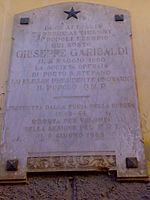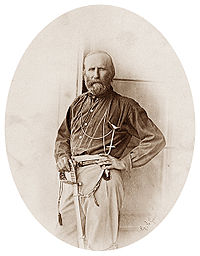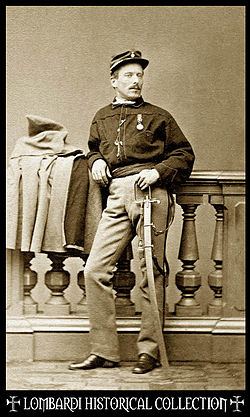- Expedition of the Thousand
-
Expedition of the Thousand 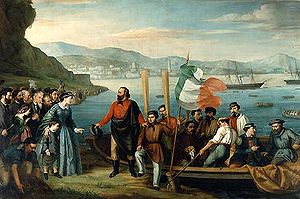
The beginning of the expedition at Quarto.Date 1860–1861 Location Sicily, Southern Italy Result Decisive Sardinian/Italian victory, collapse of the Kingdom of the Two Sicilies Territorial
changesConquest of Southern Italy for the newly formed Kingdom of Italy Belligerents  Kingdom of Sardinia/Italy
Kingdom of Sardinia/Italy
 Royal Navy
Royal Navy
 Hungarian legion of Italia[1]
Hungarian legion of Italia[1] Kingdom of the Two Sicilies
Kingdom of the Two SiciliesCommanders and leaders  Giuseppe Garibaldi
Giuseppe Garibaldi
 Nino Bixio
Nino Bixio
 Enrico Cialdini
Enrico Cialdini Francis II of the Two Sicilies
Francis II of the Two Sicilies
 Ferdinando Lanza
Ferdinando Lanza
 Giosuè Ritucci
Giosuè Ritucci
 Pietro Carlo Maria Vial de Maton
Pietro Carlo Maria Vial de MatonThe Expedition of the Thousand (Italian Spedizione dei Mille) was a military campaign led by the revolutionary general Giuseppe Garibaldi in 1860. A force of volunteers defeated the Kingdom of the Two Sicilies, leading to its dissolution and annexation by the Kingdom of Sardinia, an important step in the creation of a newly unified Kingdom of Italy.
Contents
Background
The events of the Expedition took place within the overall process of the unification of Italy, which was largely orchestrated by Camillo Cavour, Prime Minister of Sardinia-Piedmont, as his life's work. After the annexation of the Grand Duchy of Tuscany, the Duchies of Modena and Parma and the Romagna to Piedmont in March 1860, Italian nationalists set their sights on the Kingdom of the Two Sicilies, which comprised all of southern mainland Italy and Sicily, as the next step toward their dream of unification of all Italian lands.
In 1860 Garibaldi, already the most famous Italian revolutionary leader, was in Genoa planning an expedition against Sicily and Naples, with the covert support of the United Kingdom[2]. Sicilian leaders, among them Francesco Crispi, were discontented with Neapolitan rule over the island..[citation needed] Moreover Britain was worried by the approaches of the Neapolitans towards the Russian Empire in the latter's attempt to open its way to the Mediterranean Sea; the strategic importance of the Sicilian ports was also to be dramatically increased by the opening of the Suez Canal.[citation needed] It has been also suggested (by Lorenzo del Boca, among the others) that British support for Garibaldi's expedition was spurred by the necessity to obtain more favourable economic conditions for Sicilian sulfur, which was needed in great quantities for the new steamers.[3]
The search for a casus belli
The Kingdom of Sardinia-Piedmont needed a presentable casus belli in order to attack the Kingdom of the Two Sicilies. This was needed for the House of Savoy, which however never gave any declaration of war against the Bourbon kingdom, a necessary condition, since this was among the requirements presented to Cavour. The only occurrence that would have satisfied this requirement was an uprising from within. Such an event would have felt the alienation of the people to the dynasty that ruled in Naples and, particularly, the inability of Francis of Bourbon, to ensure, in forms acceptable public policy in their domains. Sicily, as shown by the history of the past decades, was fertile ground, and the liberal south, especially those returning after an amnesty granted by the young King, who worked in this direction for some time.[4][5]
The expedition
Landing in Sicily
The expedition set sail on the evening of May 5, 1860 from a rock in Quarto, a district of Genoa, on the steamships Il Piemonte and Il Lombardo,[6] which were acquired from G.B. Fauché, a fellow freemason of Garibaldi. The corps was formed by some one thousand volunteers (Italian: Mille, whence the name), practically all northern Italians, including a woman (Rose "Rosalia" Montmasson, wife of Francesco Crispi).[7] After a short stop (May 7) at Talamone, and (May 9) at Porto Santo Stefano in southern Tuscany, for water, weapons and coal from Piedmontese troops, the vessels were directed to Sicily.
The ships landed at Marsala, on the westernmost point of Sicily, on May 11, with the help of British ships present in the harbour to deter the Bourbon ships.[8] The Lombardo was attacked and sunk only after the disembarkation had been completed, while the Piemonte was captured. The landing had been preceded by the arrival of Francesco Crispi and others, who had the task of gaining the support of the locals for the volunteers.
On May 14, at Salemi, Garibaldi announced that he was assuming dictatorship over Sicily in the name of King Victor Emmanuel II of Sardinia.
Calatafimi and Palermo
Main article: Battle of CalatafimiThe Mille won a first battle at Calatafimi against around 2,000 Neapolitan troops on May 15. The battle was inconclusive, but boosted the morale of the Mille and, at the same time, depressed the Neapolitans, who were poorly led by their often corrupted higher officers, and started to feel themselves abandoned. In the meantime the ranks of the Mille enlarged to 1,200 with local men joining. On May 27, with the help of a popular insurrection, the Mille laid siege to Palermo, the island's capital. The city was defended by some 16,000 men, but these were under the confused and timid direction of general Ferdinando Lanza, aged 75 (probably one of the Neapolitan officers bribed with English money[citation needed], see Evaluation section).
While two columns of Garibaldines attacked the perimeter, part of the population, strengthened by 2,000 prisoners liberated from the local jails, rose against the garrison. When his troops were driven back from most of their positions, Lanza ordered them to bombard the city for three days, causing the deaths of 600 civilians. By May 28 Garibaldi controlled much of the city and declared the Bourbon authority deposed. The following day a desperate Neapolitan counteroffensive was driven back, and Lanza asked for a truce. However, when a reinforcement party of well equipped and well trained troops arrived in the city, the situation became very serious for Garibaldi, who was saved only by Lanza's decision to surrender. Through the mediation of a British admiral, an armistice was signed and the Neapolitan fleet abandoned the port.
Neapolitan retreat and Battle of Milazzo
The Bourbon troops were ordered to push eastwards and evacuate the island. An insurrection that had broken out in Catania on May 31, led by Nicola Fabrizi, was crushed by the local garrison, but the order to leave for Messina meant that this Neapolitan tactical success would have no practical results.
At the time only Syracuse, Augusta, Milazzo and Messina remained in royal hands in Sicily. In the meantime the dictator Garibaldi issued his first law. A levy failed to muster more than 20,000 troops, while the peasants, who hoped to an immediate relief from the grevious conditions to which they were forced by the landowners, revolted in several localities. At Bronte, on August 4, 1860, Garibaldi's friend Nino Bixio bloodily repressed one of these revolts with two battalions of Redshirts.
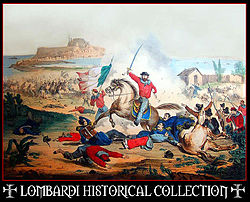

Lithograph of Garibaldi and his Red Shirts at the Battle of Milazzo. The pace of Garibaldi's victories had worried Cavour, who in early July sent him a proposal of immediate annexation of Sicily to Piedmont. Garibaldi, however, refused vehemently to allow such a move until the end of the war. Cavour's envoy, La Farina, was arrested and expelled from the island. He was replaced by the more malleable Agostino Depretis, who gained Garibaldi's trust and was appointed as pro-dictator.
On June 25, 1860, King Francis II of the Two Sicilies had issued a constitution. However, this late attempt to conciliate his moderate subjects failed to rouse them to defend the regime, while liberals and revolutionaries were eager to welcome Garibaldi.
At the time, Garibaldi had created the Esercito Meridionale ("Southern Army"), reinforced by other volunteers from Italy and some regular Piedmontese soldiers disguised as "deserters". The Neapolitans had mustered some 24,000 men for the defence of Messina and the other fortresses.
On July 20 Garibaldi attacked Milazzo with 5,000 men. The Neapolitan defence was gallant, but again the absence of coordination and the refusal of Marshal Clary, commander-in-chief of the army in the island, to send reinforcements from Messina granted the Mille another victory. Six days later Clary surrendered the city of Messina to Garibaldi, leaving only 4,000 in the citadel and other forts. The other strongholds surrendered by the end of September.
Landing and conquest in Calabria
On August 19 Garibaldi's men disembarked in Calabria, a move opposed by Cavour, who had written the Dictator a letter urging him to not cross the strait. Garibaldi, however, disobeyed, an act which had the silent approval of King Victor Emmanuel.
The Bourbons had some 20,000 men in Calabria, but, apart from some episodes like that of Reggio Calabria, which was conquered at high cost by Bixio on August 21 , they offered insignificant resistance, as numerous units of the Bourbon army disbanded spontaneously or even joined Garibaldi's ranks. On August 30 a conspicuous Sicilian army, led by general Ghio, was officially disbanded at Soveria Mannelli, while only minor and dispersed units continued the fight. The Neapolitan fleet behaved in a similar way.
The end
King Francis II was thus forced to abandon Naples and entrench himself in the formidable fortress of Gaeta, while a last stand was set up on the Volturno river, north of Naples. On September 7 Garibaldi took possession of the Kingdom's capital with little harm (he entered the city by train), hailed as a liberator by the population.
In the decisive Battle of the Volturnus (1 and 2 October[9]), Garibaldi, with a force of 24,000 men, was not able to conclusively defeat the Neapolitan Army (about 25,000 men). Only the arrival of the Piedmontese army which had crossed through the Papal territories of the Marche and Umbria, obliged the last organized Bourbon force to entrench in Gaeta.
A few days later (October 21) a plebiscite confirmed the annexation of the Kingdom of the Two Sicilies to the Kingdom of Sardinia by an overwhelming majority (for today's standards the plebiscite would be of limited significance, as the vote was not secret, and even Piedmontese soldiers voted).
The end of the expedition is traditionally set with the famous meeting in Teano[10] (northern Campania) between Victor Emmanuel and Garibaldi (October 26, 1860). Others assign instead the end of the campaign to the King's entrance into Naples on November 7.
Garibaldi asked the King to remain in the former Two Sicilies for a year as dictator. He also asked that his officers be integrated in the new Italian Army. When Victor Emmanuel refused to accept his requests, he returned to Caprera.
However, the military campaign was not yet fully completed, as Francis II held out in Gaeta until February of the next year, when he finally surrendered and left for exile in Austria. Shortly thereafter, in March 1861, the new Kingdom of Italy (Regno d'Italia) was formally established.
Evaluation
The Expedition of the Thousand has traditionally been one of the most celebrated events of the Italian Risorgimento, the process of the unification of Italy. However, recent studies[citation needed] have pointed out that later descriptions of the whole event were somewhat hagiographic, and that its effective relevance, in particular the extent of the military campaign, was overesteemed by traditional historiography.
In the following years, the rise of local resistance (the so-called brigantaggio or brigandage), required at one point the presence of some 140,000 Piedmontese troops to maintain control of the former Kingdom of the Two Sicilies. Traditionally, the handling of the brigantaggio has received a negative judgement by Italian historians, in strict contrast with the heroism attributed to Garibaldi and his followers; the English historian Denis Mack Smith[11], for example, points out the deficiencies and reticence of the sources available for the period.
The expedition, moreover, obtained the support of the powerful great landowners of southern Italy in exchange for the promise that their properties be left intact in the upcoming political settlement. Numerous Sicilian peasants, however, had joined the Mille hoping instead for a redistribution of the land to the people working it. The consequences of this misunderstanding became evident at Bronte.
See also
Notes
- ^ Magyarország hadtörténete 1. (Military history of Hungary), Zrínyi Katonai Kiadó 1984. ISBN 963-326-320-4
- ^ Del Boca, Maledetti Savoia
- ^ Lorenzo Del Boca, Maledetti Savoia, see chapter Il copyright inglese
- ^ Gigi Di Fiore, I vinti del Risorgimento, Utet, Torino, 2004, p. 99.
- ^ Giacinto De Sivo, Storia delle Due Sicilie 1847–1861, Edizioni Trabant, 2009, p. 331.
- ^ The ships were the property of Raffaele Rubattino, of whose company Fauché was administrator, and had been paid with a guaranty from King Victor Emmanuel and Prime Minister Cavour themselves. After the conclusion of the expedition the debt was extinguished by handing over to Rubattino the entire Florio fleet, captured in Sicily.
- ^ According to some sources, the exact number was 1,089. Most were from the former Lombardy-Venetia. There were some foreigners, often not cited in Italian history books, including Englishmen and Hungarian officers.
- ^ These were: Stromboli (steam corvette), Valoroso (brigandine), Partenope (sail frigate) and the armed steamer Capri. The British had the two gunboats Argus and Intrepid.
- ^ Effective date of the end of the fightings is debated.
- ^ Other sources (including Del Boca) set the location of the meeting at Taverna della Catena, in territory of the modern comune of Vairano Patenora.
- ^ Denis Mack Smith, Italy and Its Monarchy.
Sources
- Abba, Giuseppe Cesare (1880). Da Quarto al Volturno. Noterelle di uno dei Mille.
- Banti, Anna (1967). Noi credevamo.
- Bianciardi, Luciano (1969). Daghela avanti un passo. Bietti.
- Del Boca, Lorenzo (1998). Maledetti Savoia. Piemme.
- Mack Smith, Denis (1990). Italy and Its Monarchy.
- Zitara, Nicola (1971). L'unità d’Italia. Nascita di una colonia.
External links
Categories:- Conflicts in 1860
- Conflicts in 1861
- Wars involving Hungary
- Risorgimento
- History of Italy
- 1860 in Italy
Wikimedia Foundation. 2010.

